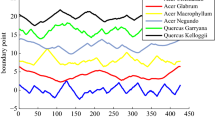Abstract
In order to improve the quality of the power load curves similarity measurement, a new similarity measurement method based on Euclidean distance is proposed in this paper . Among the commonly used similarity measurement methods, Euclidean distance is not sensitive to the fluctuation of the load curves, which results in the lack of shape measurement capability. For the numerical distribution on the timeline is not concerned, the dynamic time warping (DTW) distance is not accord with the requirement of the power system load analysis. Focus on those issues, the proposed method introduced a correction factor that contains the dynamic characteristics of the numerical difference between two power load curves without compromising time warping. The advantages and performance of the proposed method are evaluated by similarity computing and clustering analysis. As shown in the experimental results of similarity computing, the proposed method performs as same as ED and DTW, but the calculating time is less than DTW. In the clustering analysis, it also decreases the calculating time from 3.9 s to 0.595 s compared with DTW and shows better clustering effect that make the Davies-Bouldin index from 0.438 for ED and 0.325 for DTW to 0.249.
Access this chapter
Tax calculation will be finalised at checkout
Purchases are for personal use only
Similar content being viewed by others
References
Shi, L., Zhou, R., et al.: New energy-load characteristic index based on time series similarity measurement. Electr. Power Autom. Equipment 39(5), 75–81 (2019)
Lin, R., Wu, B., Su, Y.: An adaptive weighted parson similarity measurement method for load curve clustering. Energies 11, 2466 (2018)
Alvarez, F.M., Troncoso, A., Riquelme, J.C., Ruiz, J.S.A.: Energy time series forecasting based on pattern sequence similarity. IEEE Trans. Knowl. Data Eng. 23(8), 1230–1243 (2011). https://doi.org/10.1109/TKDE.2010.227
Zhou, R., et al.: Source-load-storage coordinated optimization model with source-load similarity and curve volatility constraints. Proc. CSEE 40(13), 4092–4101 (2020)
Singh, S., Yassine, A.: Big data mining of energy time series for behavioral analytics and energy consumption forecasting. Energies 11, 452 (2018)
Nagi, J., Yap, K.S., Tiong, S.K., et al.: Nontechnical loss detection for metered customers in power utility using support vector machines. IEEE Trans. Power Delivery 25(2), 1162–1171 (2010)
Yu, K., Guo, G., et al.: Quantum algorithms for similarity measurement based on euclidean distance. Int. J. Theor. Phys. 59, 3134–3144 (2020)
Mei, J., Liu, M., Wang, Y., Gao, H.: Learning a mahalanobis distance-based dynamic time warping measure for multivariate time deries vlassification. IEEE Trans. Cybern. 46(6), 1363–1374 (2016)
Li, Z., Yuan, J.: An estimation similarity measure method based on the characteristic of vector difference. Int. J. Inf. 14(3), 1067–1074 (2011)
Jia, H.M., He, G.Y., Fang, C.X., Li, K.W., Yao, Y.Z., Huang, M.M.: Load forecasting by multi-hierarchy clustering combining hierarchy clustering with approaching algorithm in two directions. Power Syst. Technol 31, 33–36 (2007)
Yu, J., Amores, J., Sebe, N., Radeva, P., Tian, Q.: Distance learning for similarity estimation. IEEE Trans. Pattern Anal. Mach. Intell. 29, 451–462 (2008)
Teeraratkul, T., O’Neill, D., Lall, S.: Shape-based approach to household electric load curve clustering and prediction. IEEE Trans. Smart Grid 9(5), 5196–5206 (2018)
Gao, M., Gong, T., Lin, R., et al.: A power load clustering method based on limited DTW algorithm. In: Information Technology, Networking, Electronic and Automation Control Conference, Chengdu, pp. 253–256. IEEE (2019)
Lin, R., Wu, B., Su, Y.: An adaptive weighted pearson similarity measurement method for load curve clustering. Energies 11(9), 2466 (2018)
Acknowledgments
This work is supported by the State Grid Corporation of China (52199719002M).
Author information
Authors and Affiliations
Editor information
Editors and Affiliations
Rights and permissions
Copyright information
© 2021 ICST Institute for Computer Sciences, Social Informatics and Telecommunications Engineering
About this paper
Cite this paper
Ning, X., Zhu, K., Deng, Y., Zhang, R., Chen, Q., Li, Z. (2021). A New Similarity Measurement Method for the Power Load Curves Analysis. In: Cheng, M., Yu, P., Hong, Y., Jia, H. (eds) Smart Grid and Innovative Frontiers in Telecommunications. SmartGIFT 2020. Lecture Notes of the Institute for Computer Sciences, Social Informatics and Telecommunications Engineering, vol 373. Springer, Cham. https://doi.org/10.1007/978-3-030-73562-3_1
Download citation
DOI: https://doi.org/10.1007/978-3-030-73562-3_1
Published:
Publisher Name: Springer, Cham
Print ISBN: 978-3-030-73561-6
Online ISBN: 978-3-030-73562-3
eBook Packages: Computer ScienceComputer Science (R0)




